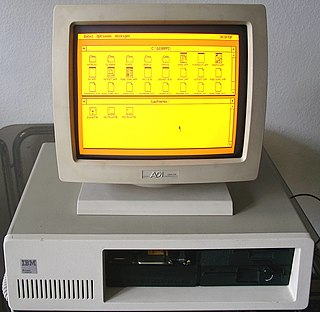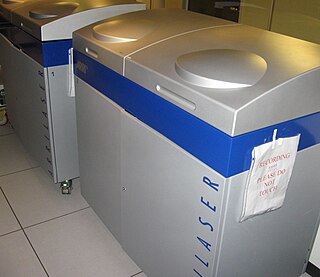Related Research Articles

GEM is an operating environment which was created by Digital Research (DRI) since 1984 for use with the DOS operating system on Intel 8088 and Motorola 68000 microprocessors.

Edwin Herbert Land, ForMemRS, FRPS, Hon.MRI was an American scientist and inventor, best known as the co-founder of the Polaroid Corporation. He invented inexpensive filters for polarizing light, a practical system of in-camera instant photography, and the retinex theory of color vision, among other things. His Polaroid instant camera went on sale in late 1948 and made it possible for a picture to be taken and developed in 60 seconds or less.
Polaroid is an American company best known for its instant film and cameras. The company was founded in 1937 by Edwin H. Land, to exploit the use of its Polaroid polarizing polymer. Land ran the company until 1981. Its peak employment was 21,000 in 1978, and its peak revenue was $3 billion in 1991.

An instant camera is a camera which uses self-developing film to create a chemically developed print shortly after taking the picture. Polaroid Corporation pioneered consumer-friendly instant cameras and film, and were followed by various other manufacturers.
Color depth or colour depth, also known as bit depth, is either the number of bits used to indicate the color of a single pixel, or the number of bits used for each color component of a single pixel. When referring to a pixel, the concept can be defined as bits per pixel (bpp). When referring to a color component, the concept can be defined as bits per component, bits per channel, bits per color, and also bits per pixel component, bits per color channel or bits per sample (bps). Modern standards tend to use bits per component, but historical lower-depth systems used bits per pixel more often.

Dolby Laboratories, Inc. is an American company specializing in audio noise reduction, audio encoding/compression, spatial audio, and HDR imaging. Dolby licenses its technologies to consumer electronics manufacturers.
The Foveon X3 sensor is a digital camera image sensor designed by Foveon, Inc., and manufactured by Dongbu Electronics. It uses an array of photosites that consist of three vertically stacked photodiodes. Each of the three stacked photodiodes has a different spectral sensitivity, allowing it to respond differently to different wavelengths. The signals from the three photodiodes are then processed as additive color data that are transformed to a standard RGB color space.

A film recorder is a graphical output device for transferring images to photographic film from a digital source. In a typical film recorder, an image is passed from a host computer to a mechanism to expose film through a variety of methods, historically by direct photography of a high-resolution cathode ray tube (CRT) display. The exposed film can then be developed using conventional developing techniques, and displayed with a slide or motion picture projector. The use of film recorders predates the current use of digital projectors, which eliminate the time and cost involved in the intermediate step of transferring computer images to film stock, instead directly displaying the image signal from a computer. Motion picture film scanners are the opposite of film recorders, copying content from film stock to a computer system. Film recorders can be thought of as modern versions of Kinescopes.

Instant film is a type of photographic film that was introduced by Polaroid Corporation to produce a visible image within minutes or seconds of the photograph's exposure. The film contains the chemicals needed for developing and fixing the photograph, and the camera exposes and initiates the developing process after a photo has been taken.

A still video camera (SVC) is a type of electronic camera that takes still images and stores them as single frames of video. They peaked in popularity in the late 1980s and can be seen as the predecessor to the digital camera. However, unlike the latter, the image storage in such cameras is based on analog technology, rather than as a digital file.

Analog photography, also known as film photography, is a catch-all term for photography that uses chemical processes to capture an image, typically on paper, film or a hard plate. These analog processes were the only methods available to photographers for more than a century prior to the invention of digital photography, which uses electronic sensors to record images to digital media.

Instax is a brand of instant still cameras and instant films marketed by Fujifilm.

The Olivetti M24 is a computer that was sold by Olivetti in 1983 using the Intel 8086 CPU.
Polaroid B.V. is a Dutch photography company that manufactures instant film for its original cameras as well as for select Polaroid Corporation instant cameras.

Zink is a full-color printing technology for digital devices that does not require ink cartridges and prints in a single pass.

DaVinci Resolve is a color grading, color correction, visual effects, and audio post-production video editing application for macOS, Windows, and Linux, originally developed by da Vinci Systems, and now developed by Blackmagic Design following its acquisition in 2009. In addition to the commercial version of the software, Blackmagic Design also distributes a free edition, with reduced functionality, simply named DaVinci Resolve.

Ellen Carey is an American artist known for conceptual photography exploring non-traditional approaches involving process, exposure, and paper. Her work has ranged from painted and multiple-exposure, Polaroid 20 x 24, Neo-Geo self-portraits beginning in the late 1970s to cameraless, abstract photograms and minimal Polaroid images from the 1990s onward, which critics often compare to color-field painting. Carey's sixty one-person exhibitions have been presented at museums, such as the Amon Carter Museum of American Art, International Center of Photography (ICP) and Wadsworth Atheneum Museum of Art, alternative spaces such as Hallwalls and Real Art Ways, and many commercial galleries. Her work is in numerous museum collections, including those of the Metropolitan Museum of Art, Whitney Museum of American Art, Los Angeles County Museum of Art, Centre Pompidou, and Smithsonian American Art Museum. In 2019, she was named one of the Royal Photographic Society (London) "Hundred Heroines", recognizing leading women photographers worldwide. Los Angeles Times critic Leah Ollman describes her photography as "inventive, physically involving, process-oriented work" and her recent photograms as "performative sculptures enacted in the gestational space of the darkroom" whose pure hues, shadows and color shifts deliver "optical buzz and conceptual bang." New York Times critic William Zimmer wrote that her work "aspires to be nothing less than a reinvention, or at least a reconsideration, of the roots or the essence of photography." In addition to her art career, Carey has also been a longtime educator at the Hartford Art School and a writer and researcher on the history of photography.
References
- ↑ "Palette Color Film Recorders Overview" (PDF). Retrieved 2016-09-20.
- ↑ "Imaging driver list for Intel GEM". Seasip.info. 2005-09-02. Retrieved 2016-09-20.
- ↑ "Polaroid Digital Palette film recorder". philpem.me.uk. 2012-11-04. Retrieved 2016-09-20.
- ↑ "ProPalette 8K Launch Brief" (PDF). Retrieved 2016-09-20.
- ↑ "Olivetti-Mikro verfügbar - channelpartner.de". Archived from the original on 2016-11-24. Retrieved 2016-11-23.